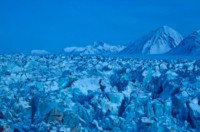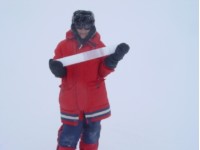|
|
Glaciers
 Glaciers move like slowly flowing rivers. If the angle of the ground beneath them steepens, or other conditions cause the glacier to move forward more quickly, it fractures, as this photograph of crevasses shows. It is the uppermost 50 metres of the glacier which fracture; further down the pressure is so great that the glacier behaves more plastically and flows. Crevassed areas can be hazardous for both people and animals, especially if the crevasses are covered by snow so that they are difficult to see.
Illustration: NPI
Even though you perhaps would not think so, in general little precipitation falls in the arctic regions. The glaciers therefore act as reservoirs for Arctic Ltd. Most animals are dependent upon fresh water to quench their thirst or to wash, and the glaciers help with this in the shape of meltwater. In addition, they act as thermostats for Arctic Ltd. They reflect the sun's rays, and thus help to control the precipitation and ensure that the tem-perature in the production halls is comfortably low.
Glaciers move like slowly flowing rivers. If the angle of the ground beneath them steepens, or other conditions cause the glacier to move forward more quickly, it fractures, as this photograph of crevasses shows. It is the uppermost 50 metres of the glacier which fracture; further down the pressure is so great that the glacier behaves more plastically and flows. Crevassed areas can be hazardous for both people and animals, especially if the crevasses are covered by snow so that they are difficult to see.
Illustration: NPI
Even though you perhaps would not think so, in general little precipitation falls in the arctic regions. The glaciers therefore act as reservoirs for Arctic Ltd. Most animals are dependent upon fresh water to quench their thirst or to wash, and the glaciers help with this in the shape of meltwater. In addition, they act as thermostats for Arctic Ltd. They reflect the sun's rays, and thus help to control the precipitation and ensure that the tem-perature in the production halls is comfortably low.
Over half of Svalbard is covered by glaciers – there are more than 2100 small and large glaciers here and nearly 60 % of the land area is covered by ice. The largest glaciers are called ice caps and are mainly found on the east side of Svalbard. The largest one is Austfonna on the island of Nordaustlandet. It is about 8450 km2 and is the largest ice cap in the world apart from the enormous ones in the Antarctic and Greenland.
 Glaciers may function as enormous climate archives. As time goes by, more and more snow falls on the glacier. If the snow does not thaw, it is stored deeper and deeper in the glacier as new snow falls above it. When a drill core is brought up from a glacier, it can be understood as a time line where the bottom is oldest and the top youngest. When tiny air bubbles and particles inside the ice are analysed, scientists can obtain information about the climate and how the conditions around the glacier have changed during its lifetime, which may be 100 000 years.
Illustration: Elisabeth Isaksson, NPI
The glaciers in central parts of Spitsbergen are much smaller than those further east, due to the drier climate and less snowfall in winter. They are called cold glaciers because they are frozen fast to the bedrock beneath and move only about 1-2 metres a year. Out on the coast, on the other hand, there are warm glaciers which are not frozen fast to their subsurface and which can move a long way in a short time.
Glaciers may function as enormous climate archives. As time goes by, more and more snow falls on the glacier. If the snow does not thaw, it is stored deeper and deeper in the glacier as new snow falls above it. When a drill core is brought up from a glacier, it can be understood as a time line where the bottom is oldest and the top youngest. When tiny air bubbles and particles inside the ice are analysed, scientists can obtain information about the climate and how the conditions around the glacier have changed during its lifetime, which may be 100 000 years.
Illustration: Elisabeth Isaksson, NPI
The glaciers in central parts of Spitsbergen are much smaller than those further east, due to the drier climate and less snowfall in winter. They are called cold glaciers because they are frozen fast to the bedrock beneath and move only about 1-2 metres a year. Out on the coast, on the other hand, there are warm glaciers which are not frozen fast to their subsurface and which can move a long way in a short time.
Many glaciers in Svalbard are surge glaciers. Surge glaciers are so called because they can undertake rapid advances; the snout may move several metres a day before it stops and melts slowly back. Such glaciers are only found in Svalbard, on the islands in Arctic Canada and in Alaska. Little is known about what triggers such an advance and how much time passes between each time a glacier surges, but in Svalbard it seems that the interval may be between 30 and 500 years.
Did you know...
 The Bråsvellbre Glacier, an arm of the Austfonna ice cap in Svalbard, surged in 1937 and 1938. This is a natural process. In the course of just over a year, the glacier advanced as much as 20 kilometres. This was how the glacier got its name, since Bråsvell means 'sudden swelling'.
The Bråsvellbre Glacier, an arm of the Austfonna ice cap in Svalbard, surged in 1937 and 1938. This is a natural process. In the course of just over a year, the glacier advanced as much as 20 kilometres. This was how the glacier got its name, since Bråsvell means 'sudden swelling'.
 A relief map of Svalbard clearly shows that large parts of Svalbard are covered by massive ice. Note the outstanding size of the Austfonna ice cap on Nordaustlandet. A relief map of Svalbard clearly shows that large parts of Svalbard are covered by massive ice. Note the outstanding size of the Austfonna ice cap on Nordaustlandet.
Illustration: NPI
|



|